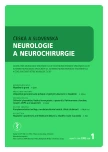Optic neuritis caused by mucocele of paranasal sinuses – a casual link or a coincidence? A case study
Authors:
P. Čelakovský; J. Vokurka; M. Lánský; K. Zborayová
Authors‘ workplace:
LF UK a FN v Hradci Králové
; Ušní, nosní a krční klinika
Published in:
Cesk Slov Neurol N 2008; 71/104(1): 89-92
Category:
Case Report
Overview
Extension of inflammation into the orbit in acute and chronic sinusitis is not a rare situation, as a result of the close anatomical vicinity of the orbit and paranasal sinuses (PS). Also well documented are cases of damage to the optic nerve during endoscopic surgery of the paranasal sinuses. However, opinions still diverge on the possibility of optic neuritis developing in pathological processes in the posterior ethmoid and sphenoid sinuses region. The possibility of retrobulbar neuritis developing in paranasal sinus mucoceles and pyoceles has been a recurrent topic of discussion in the relevant literature. Mucocele is a cystic, slow-growing lesion of paranasal sinuses with sterile content; pyocele contains purulent secretion and is created by secondary bacterial infection of a mucocele. The article describes a case study of a patient with sudden loss of right vision in retrobulbar neuritis. The disease was probably linked with a posterior ethmoid and right sphenoid sinus mucocele. Based on the patient's clinical condition and a CT image, endoscopic endonasal surgery of the paranasal sinuses was indicated. Post-surgical therapy included general corticoids and antibiotics, yet the patient's vision did not improve. Permanent damage to the patient's vision is likely to have been caused by the time which elapsed from the loss of vision to adequate surgical treatment, i.e. more than 24 hours. Possible causes of nervous affection are discussed, including destruction of the optic canal and compression of the nerve by the pressure of the mucocele, transition of infection in the case of pyocele, or the development of occlusive vasculitis with subsequent ischemic changes.
Key words:
mucocele of lateral nasal cavities – retrobulbar neuritis – optical nerve neuropathy – functional endocsopic surgery – FESS
Sources
1. Aibara R, Kawakita S, Yumoto E, Yanagira N. Relationship of Onodi cell to optic neuritis – radiological anatomy on coronal CT scanning. Nippon Jibiinkoka Gakkai Kaiho 1997; 100: 663-670.
2. Fujitani T, Takahashi T. Rhinogenic neuropathia of the optic nerve due to muco-and pyoceles of the sphenoid sinus and posterior ethmoid cells. Laryngol Rhinol Otol 1984; 63: 361-363.
3. Rothstein J, Maisel RH, Berlinger NT, Wirtschafter JD. Relationship of optic neuritis to disease of the paranasal sinuses. Laryngoscope 1984; 94: 1501-1508.
4. Moorman CM, Anslow P, Elston JS. Is sphenoid sinus opacity significant in patients with optic neuritis? Eye 1999; 13: 76-82.
5. Buus DR, Tse DT, Farris BK. Ophthalmic complications of sinus surgery. Ophthalmology 1990; 97: 612-619.
6. Haller D, Gosepath J, Mann WJ. The management of acute visual loss after sinus surgery – two cases of rhinogenic optic neuropathy. Rhinology 2006; 44: 216-218.
7. Kim JY, Kim HJ., Kim CH, Lee JG, Yoon JH. Optic nerve injury secondery to endoscopic sinus surgery: an analysis of three cases. Yonsei Med J 2005; 46: 300-304.
8. Fujimoto N, Adachi-Usami E, Saito E, Nagata H. Optic nerve blindness due to paranasal sinus disease. Ophthalmologica 1999; 213: 262-264.
9. Matyja G, Kawczynski M, Tarnowska C. Pyocele of the posterior ethmoidal cell as the cause of visual loss. Otolaryngol Pol 2006; 60:171-174.
Labels
Paediatric neurology Neurosurgery NeurologyArticle was published in
Czech and Slovak Neurology and Neurosurgery

2008 Issue 1
Most read in this issue
- Safety of MRI in patients with metal implants and implanted devices
- Diffuse brainstem gliomas in children. A nightmare for a paediatric oncologist.
- Myasthenia gravis
- Clinical use of antibodies in multiple sclerosis
